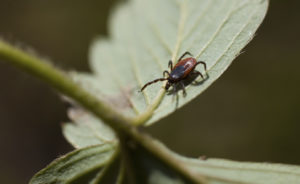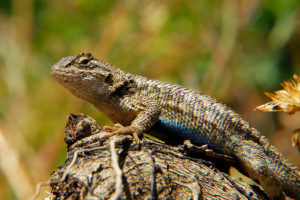SPACE COAST DAILY HEALTH SPOTLIGHT: Lyme Disease Most Common Tick-Borne Disease In U.S.
By William “Barry” Inman, BA/BS, CIC, CHE and Stephanie Hill, RN, MSN, SANE-A // April 20, 2017
300,000 infections occur each year in the U.S.

EDITOR’S NOTE: We are delighted to welcome Barry Inman, epidemiologist for the Florida Department of Health-Brevard County, and his colleague Registered Nurse epidemiologist, Stephanie Hill, to provide an update on and insight into Lyme Disease, the most common vector-borne illness in the United States.
Although Florida is a “low incidence” region for the transmission of Lyme Disease, outdoor enthusiast who travel to the Northeast and upper Midwest regions of the country should have a keen awareness and understanding of the threat of tick bite and know how to prevent Lyme disease transmission.
– Dr. Jim Palermo, Editor-in-Chief
MERRITT ISLAND, FLORIDA — Lyme disease, a spirochetal infection caused primarily by Borrelia burgdorferi, is the most common tick-borne disease in the U.S.
Lyme Disease Prevalent In Northeast and Upper Midwest, Low Incidence In Florida
According to the Centers for Disease Control and Prevention (CDC), an estimated 300,000 infections occur each year in the United States, with 95 percent of the confirmed cases in 2015 originating from 14 states in the northeast and upper Midwest.
Florida is considered a low incidence state with 0.6 confirmed cases per 100,000 of the population in 2015. In comparison, in 2015 Connecticut’s incidence rate was 52.2 confirmed cases per 100,000 of the population.
A low-incidence state is defined as a state with a disease incidence of less than 10 confirmed cases per 100,000 population.

A case is considered confirmed in the state of Florida based on one of three criteria:
1) Physician diagnosed erythema migrans (EM) rash after exposure in a high incidence area;
2) A case of EM with laboratory evidence of infection after a known exposure in a low incidence state;
3) At least one late clinical manifestation that has laboratory evidence of infection. With Lyme diagnosis the epidemiology must be considered, as the likelihood of exposure is as significant as the correct lab work.
Use Of Permethrin and DEET May Prevent ‘Blacklegged Tick’ Bites
Lyme disease is transmitted by the blacklegged tick (Ixodes scapularis) in the northeastern U.S. and upper midwestern U.S. and the western blacklegged tick (Ixodes pacificus) along the Pacific coast. Risk of Lyme transmission increases based on travel to those highly endemic areas previously listed, in combination with outdoor activity in those areas.

The blacklegged tick lives in moist environments and brush and waits for a host to brush up against wooded areas.
The risk of transmitting the B. burgdorferi then increases if the tick remains attached to skin for over 24 to 36 hours. Therefore tick checks and other preventative measures like application of permethrin and 20 percent DEET products to clothing and gear are beneficial for protection.
Florida’s Ubiquitous Lizards Help to Lower Lyme Disease Transmission
Although the blacklegged tick (I. scapularis) has a presence in Florida, this does not correlate with risk of contracting the disease in this “low-incidence” state. Many factors determine risk for Lyme.
An abundance of the ticks that carry Lyme must be present, have available hosts, and prevalence of infection. A particularly virulent strain of B. burgdorferi called OspC type A is prevalent in the northeastern United States.
This genotype has a high transmission frequency among ticks, appears to be increasing in frequency in nature, and may have been important in the emergence of Lyme disease in the northeastern United States during the late 20th century.

During the various stages of the female tick life-cycle (larvae, nymphs, and adult) a blood meal is necessary. In the north this may occur as the tick surfaces in temperatures above freezing.
This happens over a two-year life cycle. Acquisition of the spirochetal infection is typically during the larvae phase, as the primary host is the infected white-footed mouse, however, other birds and rodents may suffice as food depending on their prevalence.
It’s this availability of a host and the climate that is hypothesized to provide protection to the southeastern United States as it relates to the incidence of Lyme disease.
Lizards are plentiful in the southeast and serve as hosts for immature I. scapularis. Since lizards may be relatively refractory hosts for B. burgdorferi, lizards may reduce tick infection rates, thus serving as “zooprophylactic hosts” and lowering transmission potential in the south. The peak incidence for the onset of early Lyme disease in the eastern United States occurs during the summer months of June, July, and August.
Two-Step Testing Process Necessary For Definitive Diagnosis
The CDC currently recommends a two-step process when testing blood for evidence of antibodies against the Lyme disease bacteria. The first step should not be skipped as this can lead to false positives, misdiagnosis and improper care.
The first step uses a testing procedure called enzyme immunoassay (EIA) or rarely, an indirect immunofluorescence assay (IFA). If this first step is negative, no further testing of the specimen is recommended.
If the first step is positive or indeterminate, the second step should be performed. The second step uses a test called an immunoblot test, commonly, a “Western blot” test. Results are considered positive only if the EIA/IFA and the immunoblot are both positive.
When considering the Western blot test results, onset of symptoms and exposure must be considered. The western blot IGM is positive when symptom onset and exposure are within the past 30 days of testing.
If not this could be a false positive. The western blot IGG antibodies reflect symptomatology beyond a 30 day onset of symptoms and exposure. The CDC has a testing algorithm and symptom chronology guide for diagnosis of acute and late stage Lyme disease.
Inflamed Insect Bite + Flu-Like Symptoms = See Doctor Immediately
Early signs and symptoms of Lyme infection can appear three to 30 days following the bite of an infected tick.

In addition to erythema migrans or “bull’s-eye” rash, which occurs 70-80 percent of the time, and soreness near the tick bite itself, other early signs of Lyme disease infection resemble the flu and can include chills, fever, joint pain, headache and fatigue accompanied by swollen lymph nodes near the bite.
If you have flulike symptoms and an inflamed bite — even if you never saw a tick — you should see a doctor right away.
Several antibiotics are highly effective when taken during the first few weeks after the bacteria enter your body.
If Lyme disease is not treated promptly, the bacteria will move into your muscles, nerves, joints and brain, and may lead to heart arrhythmias, neurologic palsies, mental confusion and arthritis. Laboratory testing is not recommended on asymptomatic patients without risk of exposure.
If you have any questions about Lyme Disease contact Barry Inman at Florida Department of Health-Brevard County, 2575 N. Courtenay Pkwy Suite 211, Merritt Island, Florida 32953, 321-454-7106 or Barry.Inman@flhealth.gov.
ABOUT THE AUTHORS

Barry Inman
William “Barry” Inman, BA/BS, CIC has 40 years of experience as an epidemiologist, is Certified as an Infection Control Preventionist by the CBIC and received his BA and BS of the University of Florida in 1974. He is employed by the Brevard County Health Department in Merritt Island, Florida. He is responsible for control of communicable diseases by surveillance and investigation methods in the Brevard County area-Space Coast. He works directly with the Infection Control personnel in hospitals, long term care, acute long term care, NASA, etc. with assistance in identifying diseases which are communicable.
Stephanie Hill, RN, MSN, SANE-A is a Registered Nurse Epidemiologist with the Florida Department of Health-Brevard County.












